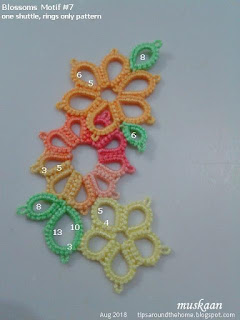Pin It now!
2nd
split/scmr pattern - bracelet
This
braid which I turned into a bracelet is a simpler version of Houtz brothers' split/scmr technique since no reverse (or unflipped) stitches are required. All tatting is
worked as normal stitches, except that the second side/half has a double core
thread. You see, we lengthen the scmr loop and use it to finger tat this half
with double stitches. Hence, I still consider it a s/scmr – perhaps a variation
or an adaptation?
Sunrise Sunset
Bracelet
braid/bracelet pattern
No
unflipped stitches ; no ends to hide !!!
I
visualized this as a sun rising above the blue horizon or skies and & then
setting on the ocean horizon. Colours were chosen accordingly.
And if you
notice, the blue bead in the sky is a different shade to the one used for the
water … there is a tinge of green in the latter, flanked by green seed beads.
Measurements :
In Anchor size 20 (close to
Lizbeth 10), the bracelet measures 6¾” X 1”.
There are 10 motif repeats.
Materials :
3 colours in Anchor size 20
(similar to Lizbeth size 10).
Shuttle 1 – red
Shuttle 2 –yellow
Ball or shuttle 3 – blue
Findings – jump rings and bracelet
clasp
Seed beads – size 16/0 - 60 transparent
yellow ; 60 transparent green
Crystals – size 8/0 – 10 red ; 10
yellow ; 10 sky blue ; 10 blue-green
Loose beads for danglers
(optional) - 2 red, 2 sky blue, & 2 yellow crystals
Abbreviations :
Sh – shuttle
s/scmr – split/self-closing mock
ring
rw – reverse work
ss – switch shuttle
b – seed bead
B – crystal
Preparation :
Prestring beads in each of the
threads as follows :
SH1 Red : 10 crystals
SH2 Yellow : [3 yellow seed beads,
one yellow crystal, 3 yellow seed beads]x10
Blue : [3 green seed beads, 1 blue-green
crystal, 3 green seed beads, one sky blue crystal]x10
Pattern
proceeds from left to right.
Part 1 : Dangler to start
In order not to hide ends, I used dangling crystals on
each thread tail on both ends.
Tie 1 crystal of same colour to each of the 3 threads.
Gather the threads at different lengths and make a larkshead knot or luggage
tag loop through jump ring, using all 3 threads.
Part 2 : Main body
** Start with Shuttle 1
(red) as core thread. Make a starting loop for scmr and use yellow for
stitches.
s/scmr1 : 2 b 2 b 2 b 2 B 2 b 2 b 2 b 2 / lengthen the loop to use as core
and finger tat with blue stitches 3 B 3. Close scmr. rw.
ss
Keep red thread at back of work.
With shuttle 2 (yellow) as core thread ….
s/scmr2 : 2 b 2 b 2 b 2 B 2 b 2 b 2 b 2 / lengthen the loop to use as core
and finger tat with red stitches 3 B 3. Close scmr. rw.
ss **
Keep red thread at back of work.
** to ** forms 1 motif. Repeat till
there are 10 motifs.
Part 3 : Dangler to end
Leave about 10-12 cms thread tails and cut. Using all 3
threads make a larkshead knot or luggage tag loop through jump ring/bracelet
clasp. Tie 1 crystal of same colour to each of the 3 threads, at different
lengths.
To
ensure the crystal knots in the 6 tails remain secure, dab a dot of fabric glue
and press/twist.
This
pattern can be shortened for earrings, or lengthened for necklace.
Trials that led up to this 2nd
s/scmr bracelet -
I
started the trials in size 40 thread. I kept messing up the onion rings!!! I’m
not a novice, so I don’t know what was happening. Not very happy with the
visual effect either.
But
I do think this picoted version has some potential. Of course, there is a lot
of switching shuttles to throw rings off.
Since
the above trials were not giving me any zing, I took the plunge directly for a
beaded bracelet version and I like how it turned out! Once the beads are strung, tatting it is pretty quick.
I
was aiming for a more curved 2nd half (like the half moon split rings), but soon realised that it is
difficult to achieve because of the double core thread. But this adaptation of the s/scmr is easier than the hmsr.
Trials for the 3rd
braid –
From
the 2 tiny rings inside a large s/scmr, it gradually evolved into a heart shape
with flower within. I still need a few more motifs to confirm and finalise.
What should I name this 3rd braid/bracelet ? All
suggestions are welcome …
I thoroughly enjoyed working the Sunrise Sunset bracelet.
Hope you enjoy it too.










































